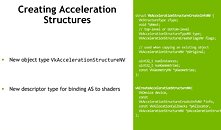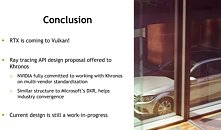- Joined
- Oct 9, 2007
- Messages
- 47,670 (7.43/day)
- Location
- Dublin, Ireland
| System Name | RBMK-1000 |
|---|---|
| Processor | AMD Ryzen 7 5700G |
| Motherboard | Gigabyte B550 AORUS Elite V2 |
| Cooling | DeepCool Gammax L240 V2 |
| Memory | 2x 16GB DDR4-3200 |
| Video Card(s) | Galax RTX 4070 Ti EX |
| Storage | Samsung 990 1TB |
| Display(s) | BenQ 1440p 60 Hz 27-inch |
| Case | Corsair Carbide 100R |
| Audio Device(s) | ASUS SupremeFX S1220A |
| Power Supply | Cooler Master MWE Gold 650W |
| Mouse | ASUS ROG Strix Impact |
| Keyboard | Gamdias Hermes E2 |
| Software | Windows 11 Pro |
NVIDIA made big moves to bring a semblance of real-time ray-tracing to the masses, with the new RTX technology, as part of its efforts to replace rasterized rendering, which has dominated 3D graphics for the past three decades. Microsoft has come out with its own extension to DirectX 12, with the new DXR API. NVIDIA is now reportedly working with the Khronos Group to bring RTX to Vulkan.
A new Vulkan extension titled "VK_NV_raytracing" surfaced in tech-documents accessed by Phoronix, which is the company's contribution to a multi-vendor standard for ray-tracing, being developed by the Khronos Group. This extension could expose several NVIDIA RTX features and presets to Vulkan. It also has similar code-structures to DXR, to minimize duplication of effort, or skill-building. NVIDIA will detail its adaptation of RTX to Vulkan further at GTC.




View at TechPowerUp Main Site
A new Vulkan extension titled "VK_NV_raytracing" surfaced in tech-documents accessed by Phoronix, which is the company's contribution to a multi-vendor standard for ray-tracing, being developed by the Khronos Group. This extension could expose several NVIDIA RTX features and presets to Vulkan. It also has similar code-structures to DXR, to minimize duplication of effort, or skill-building. NVIDIA will detail its adaptation of RTX to Vulkan further at GTC.




View at TechPowerUp Main Site



